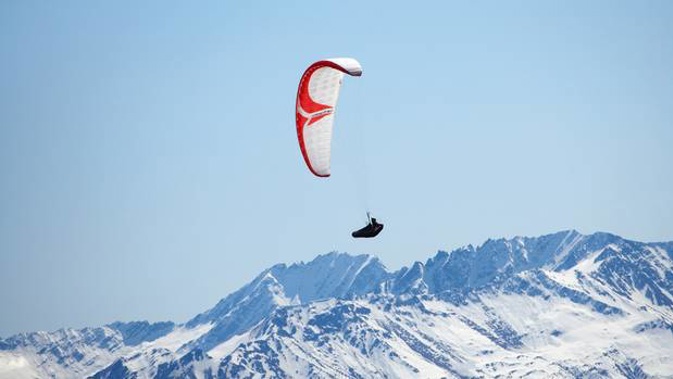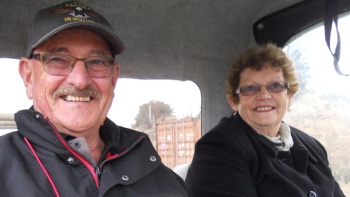
Skydivers parachuting to earth looked down to see the rotors of a helicopter - one of a growing number of near misses reported in New Zealand skies.
The incident at Franz Josef is one of 50 incidents recorded by the Civil Aviation Authority (CAA) as a near miss, since the beginning of last year, information released to the Herald on Sunday shows.
A number have been at tourism hotspots including Franz Josef, which has one of the busiest airspaces in the country because of the demand for flights over the glacier as tourist numbers soar.
Reported near-collisions increased by more than 50 per cent last year and the CAA is now developing a strategy to try and reduce such incidents.
The parachuting near miss at Franz Josef aerodrome happened on January 4 this year.
A helicopter took off and orbited above another aircraft while three tandem parachutes were open and descending to land. According to CAA notes this "caused a near miss situation with the helicopter and at least one of the tandem parachutes being only 100m apart".
In March last year there was another near-miss at Franz Josef between two helicopters. And local pilots were angered when United States Air Force F-16s flew close to a helicopter during an air show in March this year.
The Franz Josef Glacier air space is very busy during peak season, with multiple operators and more than 70,000 passengers a year.
The CAA did not specify what parties were involved in the skydiving incident. A local skydive operator didn't respond to requests for comment.
/arc-anglerfish-syd-prod-nzme.s3.amazonaws.com/public/W3Q4ABD57RHTFOZ4MP6PVJUTZM.jpg)
Flights around other tourist areas have run into problems. A paraglider over Wanaka had a near miss with a plane last September. In Queenstown, a helicopter passed within 30m of a Cessna 208 in April this year, and the next month there was another near miss as a helicopter hovered near ground level.
A helicopter lifting off from Auckland's Mechanics Bay and heading towards the Harbour Bridge took evasive action after observing a seaplane "slightly below our level and climbing".
A CAA spokeswoman said New Zealand's airspace was busier, so it wasn't unduly surprising to have more near misses.
For example, last year helicopter flying hours increased by 47,000 to 226,000. The CAA has a particular focus on airborne conflicts and the helicopter sector to improve safety, and is working with industry to identify everything that contributes to near misses.
"We're developing a strategy to ensure targeted interventions are appropriate and relevant to contributing factors such as airspace and aerodrome circuit procedure management, airspace and aerodrome circuit procedure design, and loss of situational awareness by pilots.
"Record tourist numbers have resulted in an increase in helicopter activity in popular tourist areas such as Franz Josef and Queenstown ... it's crucial for New Zealand's economy and reputation that we maintain the highest of safety standards in aviation."
There were close to 3.8m international arrivals in the year to April, up 5 per cent on the previous year.
Peter Turnbull, chair of the NZ Helicopter Association, part of Aviation NZ, said the increase in near miss incidents could reflect better reporting, given an emphasis on notifying CAA of all incidents.
/arc-anglerfish-syd-prod-nzme.s3.amazonaws.com/public/KSMEGWYL6VE35CDAKFDOOWBVCU.jpg)
Congestion was an issue in some areas, but technology to help avoid accidents was improving and safety was a strong focus.
"[The issue of near misses] is well monitored, and it is not a red flag item at this stage," said Turnbull, chief pilot with the Northland Emergency Services Trust.
Turnbull hadn't heard of the parachuting incident in Franz Josef.
"I guess one of the issues there is the parachuters are so small. But you can't just drop anywhere, it has to be in designated areas. It relies on a reporting system - see and be seen - a component of which is frequent radio calls of your intentions."
The CAA will in the coming weeks start a digital campaign around the safe use of drones. There have been 15 near miss incidents involving drones since 2017.
Seven of those happened this year. In May, a helicopter pilot was so close to a drone near Huka Falls in Taupo he could identify its make - a DJI Mavic.
Too close for comfort
The CAA has recorded 50 near miss occurrences since January 2017. These include:
• Taupo: January 2017: Aircraft took steep avoiding action after a helicopter passed close in front during an approach.
• Franz Josef: March 2017: Helicopter takes avoiding action to avoid collision with another helicopter.
• Auckland, Mechanics Bay: March 2017: Helicopter has a near miss with a seaplane.
• Wanaka: September 2017: Plane has a near miss with a paraglider.
• Franz Josef: January 2018: Tandem parachutists come within 100m of helicopter.
• Nelson: March 2018: Aircraft departing control zone had a near collision with an inbound aircraft. Estimated separation of 50m.
• Queenstown: April 2018: Helicopter passes within 30m of a plane.
• Whanganui: April 2018: A pilot in a fly over of an Anzac Day parade takes action to avoid a drone.
• Huka Falls, Taupo: May 2018: Drone flown from SH1 lookout comes within 2-4m of helicopter's rotor blades.
Source: CAA.
Take your Radio, Podcasts and Music with you









